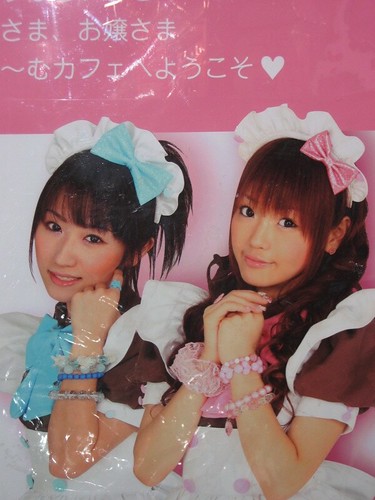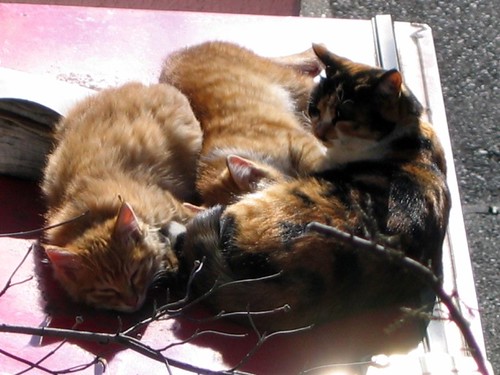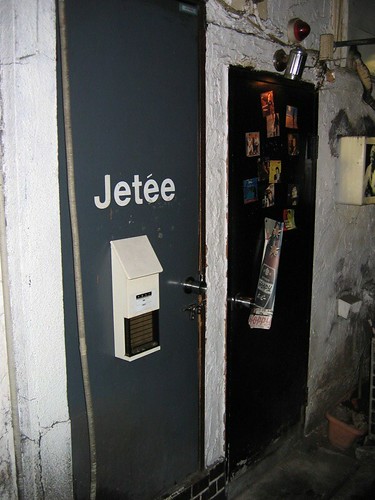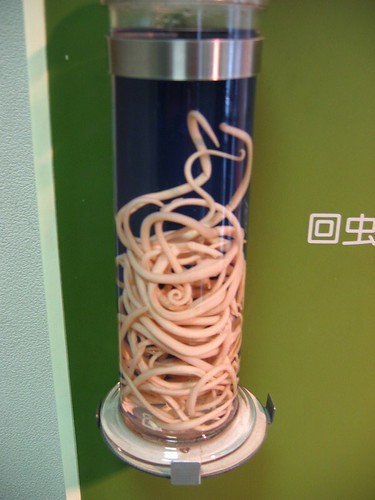According to Wikipedia, parasitism is a relationship between organisms in which one, the parasite, benefits from a prolonged close encounter with the other, the host, which is harmed. One could be forgiven then, for wondering why it is that the Meguro Parasitological Museum has become such a popular date spot for young Tokyo couples. The museum’s theme is not exactly an auspicious harbinger for nuptial bliss yet when we visited, the place was packed with twenty-somethings holding hands and staring intently at the contents of the grisly vitrines. I was a little surprised when, in front of a display of pickled tape worms, a stream of brown liquid started to run down the pant leg of a young man, who was chatting animatedly to the girl next to him. Neither of them seemed to notice and they just kept talking. “Sumimasen,” I interrupted, pointing to the puddle expanding on the floor around his feet. He looked a little shocked and extracted a leaking cup of take out coffee from his coat pocket. I was quite relieved when I found out that was all it was. And that love in the company of parasites could still be that distracting.
|
||||||

moe 
kawaii Our first morning in Tokyo: we wake up bagged, fragged and jet-lagged having spent the night in a fifteen square metre apartment with nothing but a futon the thickness of a panty liner between us and a cold wood floor. But it’s delightful. Because outside there are some *cute* cats sleeping on a Coke machine, bathed in the golden winter sun. That’s all that matters. What is it about Tokyo and cats? They seem to be everywhere, glowering from windows and bunched up like lost fur hats in the middle of the pavement of Ueno Park. Haruki Murakami used to run a jazz club in Tokyo called Peter Cat. Chris Marker always seemed to have a cat or two in his films. He described this city and its cats so beautifully in his (1982) Sans Soleil

Jetée In Marker’s honour, we stop in at Jetée, which the owner Kawai san has decorated with cat figurines. We chat with her for a while over drinks and she tells us about Marker’s most recent film; ‘Chats perchés,’ which, sadly, we haven’t yet seen. But time is out of joint. It is the coldest winter in years and I am telling the story out of sequence. It doesn’t really matter. I’ll rely on photography. Again I think of Marker:
The Japanese have many words for cute. ‘Kawaii des ne?’ might cut it for cats but it isn’t the right flavour of cute to describe a Maid Café. So we head down to Akiba to investigate. Six stories above the street we join a queue, waiting for a tables in the At Home Café. The place is a seething madhouse of pink, with bevies of maids scurrying around, giggling and serving cupcakes and omelettes that have cartoon smiles drizzled onto them with ketchup. Every twenty minutes or so a floor show starts, where customers play games with the maids and have their pictures taken flanked by maids holding plates of cupcakes. This is the epitome of moe (mo-eh) cuteness, quite distinct from the kawaii. When she finishes pouring my tea, our maid shows me how to jiggle my arms and make a heart shape with my thumbs and forefingers, while I coo: “o-o-o-o-h . . . . mo-e !” appreciatively at my cup. |
||||||
|
Powered by WordPress · Atahualpa Theme by BytesForAll |
||||||




